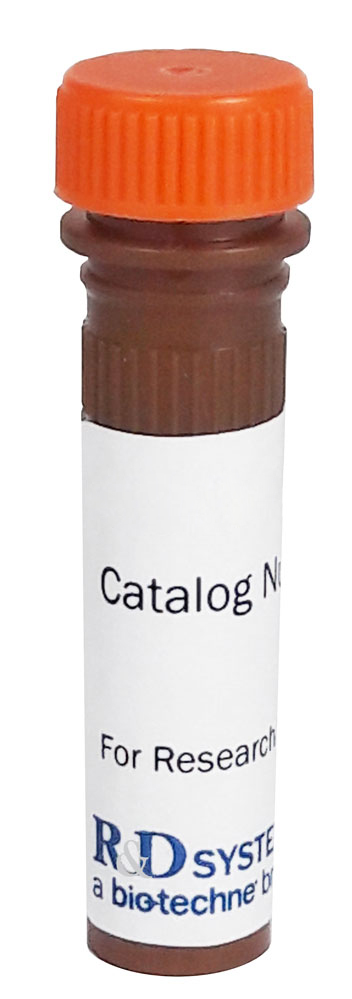Mouse TLR9 Alexa Fluor® 700-conjugated Antibody
Mouse TLR9 Alexa Fluor® 700-conjugated Antibody Summary
Leu26-Asp818
Accession # AAK29625
Applications
Please Note: Optimal dilutions should be determined by each laboratory for each application. General Protocols are available in the Technical Information section on our website.
Reconstitution Calculator
Preparation and Storage
- 12 months from date of receipt, 2 to 8 °C as supplied.
Background: TLR9
TLR9 (Toll‑like receptor 9), designated CD289, is a member of the TLR family of innate immune receptors that is mainly expressed by colonic epithelium, CD123+ plasmacytoid predendritic cells (pDC), and splenic transitional B cells (1‑9). TLR9 responds to unmethylated DNA CpG motifs that occur mainly in bacteria and viruses (1, 2). Mouse TLR9 cDNA encodes a 1032 amino acid (aa) type I transmembrane glycoprotein with a 793 aa extracellular domain (ECD) that contains 26 leucine‑rich repeats (LRRs, aa 26‑818), and a 193 aa cytoplasmic domain with a TIR sequence that dimerizes with signaling adaptors such as MyD88 (1). The mouse TLR9 ECD shares 87% aa sequence identity with rat and 71‑74% with human, feline, canine, equine, porcine, bovine and ovine TLR9. Predicted splice forms vary at the N‑terminus by initiating either upstream or downstream of the standard site. The full-length 150 kDa form, which is ligand‑binding but nonsignaling, is found in the endoplasmic reticulum. It undergoes accessory protein-mediated translocation either to the cell membrane or to lysosomes (1‑3). TLR9 is cleaved to remove LRR1‑14, producing an 80 kDa signaling fragment within acidic endolysosomes where it encounters microbial CpG DNA rather than self-DNA (2, 10, 11). However, immune complexes of self‑DNA with lupus erythematosus anti‑DNA antibodies can induce TLR9 activation and IFN‑ alpha production in pDC (4). A soluble form also found in endosomes includes all 26 LRRs and negatively regulates active TLR9 (12). Activation of TLR9 contributes to splenocyte proliferation, pDC maturation, macrophage inflammatory cytokine production, Th1 inflammatory responses, NK cell activation and recruitment, B cell surface MHC class II up‑regulation and immunoglobulin production, and generation and maintenance of memory B cells (1, 5‑9).
- Hemmi, H. et al. (2000) Nature 408:740.
- Barton, G.M. et al. (2006) Nat. Immunol. 7:49.
- Latz, E. et al. (2004) Nat. Immunol. 5:190.
- Barrat, F.J. et al. (2005) J. Exp. Med. 202:1131.
- Krieg, A.M. et al. (1995) Nature 374:546.
- Aranburu, A. et al. (2010) J. Immunol. 185:7293.
- Guerrier, T. et al. (2012) J. Autoimmun. 39:173.
- Guillerey, C. et al. (2012) Blood 120:90.
- Cunningham-Rundles, C. et al. (2006) J. Immunol. 176:1978.
- Ewald, S.E. et al. (2008) Nature 456:658.
- Park, B. et al. (2008) Nat. Immunol. 9:1407.
- Chockalingam, A. et al. (2011) Eur. J. Immunol. 41:2176.
Product Datasheets
Product Specific Notices
This product is provided under an agreement between Life Technologies Corporation and R&D Systems, Inc, and the manufacture, use, sale or import of this product is subject to one or more US patents and corresponding non-US equivalents, owned by Life Technologies Corporation and its affiliates. The purchase of this product conveys to the buyer the non-transferable right to use the purchased amount of the product and components of the product only in research conducted by the buyer (whether the buyer is an academic or for-profit entity). The sale of this product is expressly conditioned on the buyer not using the product or its components (1) in manufacturing; (2) to provide a service, information, or data to an unaffiliated third party for payment; (3) for therapeutic, diagnostic or prophylactic purposes; (4) to resell, sell, or otherwise transfer this product or its components to any third party, or for any other commercial purpose. Life Technologies Corporation will not assert a claim against the buyer of the infringement of the above patents based on the manufacture, use or sale of a commercial product developed in research by the buyer in which this product or its components was employed, provided that neither this product nor any of its components was used in the manufacture of such product. For information on purchasing a license to this product for purposes other than research, contact Life Technologies Corporation, Cell Analysis Business Unit, Business Development, 29851 Willow Creek Road, Eugene, OR 97402, Tel: (541) 465-8300. Fax: (541) 335-0354.
FAQs
No product specific FAQs exist for this product, however you may
View all Antibody FAQsReviews for Mouse TLR9 Alexa Fluor® 700-conjugated Antibody
There are currently no reviews for this product. Be the first to review Mouse TLR9 Alexa Fluor® 700-conjugated Antibody and earn rewards!
Have you used Mouse TLR9 Alexa Fluor® 700-conjugated Antibody?
Submit a review and receive an Amazon gift card.
$25/€18/£15/$25CAN/¥75 Yuan/¥2500 Yen for a review with an image
$10/€7/£6/$10 CAD/¥70 Yuan/¥1110 Yen for a review without an image









